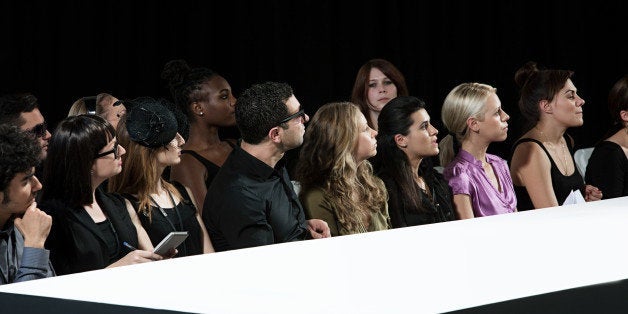
Gender is so hot right now -- well, the dismantling of "traditional" gender norms across the fashion world to be exact. The evidence is everywhere, from Jaden Smith defying traditional dress codes for Louis Vuitton's latest catalogue, to designers like Andre Landeros Michel and Marc Jacobs blurring the binary in their latest "genderless" and "gender fluid" collections for New York Fashion Week. In a recent interview with The Huffington Post, Landeros Michel stated that "Genderless/agender/unisex clothing is a direct response to the feminist and LGBT rights movements," adding that genderless fashion works to usher in gender equality.
Genderless and gender fluid fashion is certainly nothing new, but with each spring or fall collection images or statements that I come across, I notice more and more of a push for the normalization of the "unisex" or "androgynous" (read: wealthy, white, skinny, cisgender-hetero, able-bodied) body in (extremely expensive) gender fluid, genderless or unisex clothing on a runway, in a way that also completely negates and erases the lived experiences of those who lie outside of the binary.
And although I want to applaud the undoing of gender in every which way, these images leave me, along with plenty of other folks who identify as gender non-conforming, non-binary trans, genderqueer, androgynous and everyone in between, asking a lot of questions -- What audiences are these designers trying to reach out to, and at whose expense -- i.e., who is this sense of normalization and 'visibility' really for? Where do gender nonconforming, trans and non-binary folks fit in this illusion of a progressive, post-gender fashion world when many, especially those of us who are also people of color, regularly experience violence and harassment? Rather than push for the normalization and visibility of non-binary bodies in a way that is coopted by the fashion world, there needs to be a recognition and celebration of identities and presentations that fall both outside of the binary and across spectrum, for and by folks that lie outside of the binary and across spectrum, in a way that doesn't tokenize and make a spectacle out of us.
Along with this push for normalization, the fashion industry stresses the desire to promote the visibility and the "respectability" of those whose dress and expression defies socially constructed gender roles. However, the subject of 'visibility' is very complex and difficult to assess when your non-binary or non-conforming gender presentation, gender expression and/or gender identity make you more vulnerable to physical danger and verbal harassment on a day-to-day basis. In some instances -- yes, you do want people to notice your blazer ensemble finished off with a new pair of wingtips, or your shimmery, sequin button down, or even just your freshly painted nails and dress. But there is a tremendous difference between the sense of visibility that comes with walking down the street and having people admiringly study your outfit, and the endangering sense of visibility that comes from having someone trying to "figure you out," which can lead to harassment. Many of the images we see on runways depoliticize the non-binary and gender non-conforming body, and as much as I'd like to believe that this rise in high-end genderless fashion is reflective of our "evolving" views on gender as a society, I don't. Especially when trans-femme identified folks are frequently excluded from this conversation, and since 2015 saw the highest report of trans murders in U.S. history (we also have to take into account the number of murders that weren't reported, as well as the number of trans people who are often misgendered, even after their death).
The reality is that as a person living outside of the gender binary in everyday life, one has to navigate their body through an actively phobic public sphere that denies you social agency and penalizes you for your presentation and/or identity, and oftentimes (lack of) visibility can determine the level of one's safety. Complete visibility without having the fear of being attacked is a privilege many of us do not have, but this is especially true for gender non-conforming, non-binary and trans women of color.
Much of the conversation around "genderless" fashion is situated in the future, where old prejudices have no place, and norms, such as modes of dress that adhere to the gender binary, are rendered obsolete. However, this can be lumped together with other neoliberalist discourses that similarly push for sameness and homogeneity (read: "marriage equality" or "post-racial/post-black" societies), rather than strive to dismantle oppressive apparatuses and systems. These discourses typically understate the privileges of the white, cis-het body and negate lived experiences of gender-based phobias and violences, making it difficult to comply with the idea of the fashion industry wanting to sell us the dissolution of gender as a fantasy of the future -- a sort of "post-gender" blueprint -- when our experiences in the present day are so rooted in violence, and when our narratives are erased.